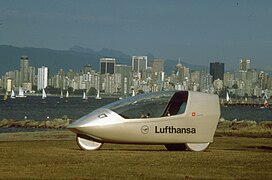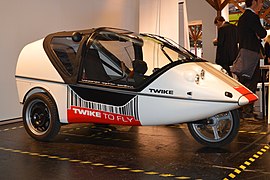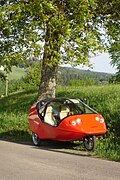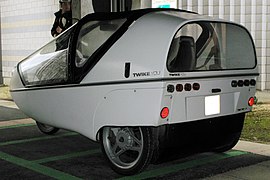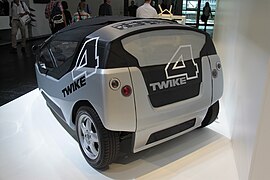
The Porsche Cayenne is a series of automobiles manufactured by the German company Porsche since 2002. It is a luxury crossover SUV and has been described as both a full-sized and a mid-sized vehicle. The first generation was known internally within Porsche as the Type 9PA (955/957) or E1. It was the first V8-engined vehicle built by Porsche since 1995, when the Porsche 928 was discontinued. It is also Porsche's first off-road variant vehicle since its Super and Junior tractors of the 1950s, and the first Porsche with four doors. Since 2014, the Cayenne has been sold alongside a smaller Porsche SUV, the Macan.

A tricycle, sometimes abbreviated to trike, is a human-powered three-wheeled vehicle.

A velomobile ; velomobiel, velo, or bicycle car is a human-powered vehicle (HPV) enclosed for aerodynamic advantage and/or protection from weather and collisions. Velomobiles are similar to recumbent bicycles, pedal go-karts and tricycles, but with a full fairing and are not to be confused with purpose-built mobiles for racing or speed records fully faired vehicles with two wheels, generally called streamliners. Streamliners have set many speed and distance records.

The Volvo C30 is a three-door, front-engine, front-wheel-drive premium compact hatchback, manufactured and marketed by Volvo Cars from 2006 to 2013, in a single generation. Powered by inline-four and straight-five engines, the C30 is a variant of the Volvo S40/V50/C70 range, sharing the same Ford C1/Volvo P1 platform. Volvo marketed the C30 as a premium hatchback / sports coupe.
Hybrid Synergy Drive (HSD), also known as Toyota Hybrid System II, is the brand name of Toyota Motor Corporation for the hybrid car drive train technology used in vehicles with the Toyota and Lexus marques. First introduced on the Prius, the technology is an option on several other Toyota and Lexus vehicles and has been adapted for the electric drive system of the hydrogen-powered Mirai, and for a plug-in hybrid version of the Prius. Previously, Toyota also licensed its HSD technology to Nissan for use in its Nissan Altima Hybrid. Its parts supplier Aisin offers similar hybrid transmissions to other car companies.

The Chevrolet S-10 Electric was an American electric-powered vehicle built by Chevrolet. It was introduced in 1997, becoming the world's first electric pickup truck from the original manufacturer, updated in 1998, and then discontinued. It was an OEM BEV variant of Chevrolet's S-10 pickup truck. The S-10 Electric was solely powered by electricity (batteries) and was marketed primarily to utility fleet customers.

A motorized bicycle is a bicycle with an attached motor or engine and transmission used either to power the vehicle unassisted, or to assist with pedalling. Since it sometimes retains both pedals and a discrete connected drive for rider-powered propulsion, the motorized bicycle is in technical terms a true bicycle, albeit a power-assisted one. Typically they are incapable of speeds above 52 km/h (32 mph), however in recent years larger motors have been built, allowing bikes to reach speeds of upwards of 72 km/h.
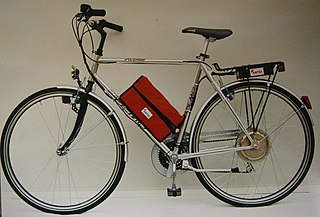
An electric bicycle, e-bike, electrically assisted pedal cycles, or electrically power assisted cycles is a motorized bicycle with an integrated electric motor used to assist propulsion. Many kinds of e-bikes are available worldwide, but they generally fall into two broad categories: bikes that assist the rider's pedal-power and bikes that add a throttle, integrating moped-style functionality. Both retain the ability to be pedaled by the rider and are therefore not electric motorcycles. E-bikes use rechargeable batteries and typically are motor-powered up to 25 to 32 km/h. High-powered varieties can often travel more than 45 km/h (28 mph).

The CityEl is a 3-wheel lightweight electric car originally designed and manufactured in Denmark, but currently made in Germany by Citycom GmbH.

A Pedelec or EPAC, is a type of low-powered electric bicycle where the rider's pedalling is assisted by a small electric motor. However, unlike some other types of e-bikes, pedelecs are classified as conventional bicycles in many countries by road authorities rather than as a type of electric moped. Pedelecs have an electronic controller that cuts power to the motor when the rider is not pedalling or when a certain speed – usually 25 km/h (16 mph) or 32 km/h (20 mph) – is reached. Pedelecs are useful for people who ride in hilly areas or in strong headwinds. While a pedelec can be any type of bicycle, a pedelec city bike is very common. A conventional bicycle can be converted to a pedelec with the addition of the necessary parts, e.g., motor, battery, etc.
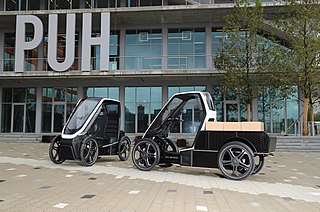
A human–electric hybrid vehicle is a hybrid vehicle, or more specifically a hybrid human-powered vehicle, whose drivetrain consists of a human being and an electric motor/generator. Some vehicles are able to operate off both human power and be plugged in to operate on battery power.

The Porsche 918 Spyder is a high performance sports car manufactured by German marque Porsche. The 918 Spyder is a plug-in hybrid powered by a mid-mounted naturally aspirated 4.6 L (4,593 cc) V8 engine, developing 447 kW at 8,700 RPM, with two electric motors delivering an additional 210 kW for a combined output of 652 kW (875 hp) and 1,280 N⋅m (944 lbf⋅ft) of torque. The 918 Spyder's 6.8 kWh lithium-ion battery pack delivers an all-electric range of 19 km (12 mi) under the US Environmental Protection Agency's five-cycle tests.
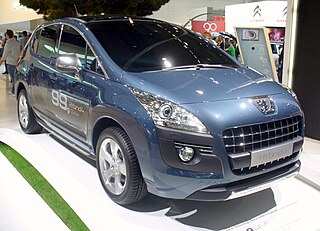
HYbrid4 is PSA Peugeot-Citroën's in-house developed TTR hybrid powertrain system, shared between the two manufacturers. It takes the form of a diesel engine powering the front wheels coupled with an electric motor powering the rear wheels to provide a 4WD hybrid with a short fully electric range. The system made its production debut on the Peugeot 3008 HYbrid4 in 2011, emitting 99 g of carbon dioxide per kilometer. The 3008 HYbrid4 returns combined fuel consumption of 3.8 litres/100 km, beating the smaller Toyota Prius. It also operates in four driver-selected modes: Auto, Sport, ZEV (pure-electric) and 4WD. This technology is not as widespread in Europe as it is in the United States and Canada.

The Volkswagen Golf (Mk7) is a C-segment car manufactured by German automobile manufacturer Volkswagen. It is the seventh generation in the Golf series and the successor to the Golf Mk6. It was introduced in Berlin on 4 September 2012, before a public launch at the 2012 Paris Motor Show. Sales in Europe began with the model in November 2012.

Car controls are the components in automobiles and other powered road vehicles, such as trucks and buses, used for driving and parking.
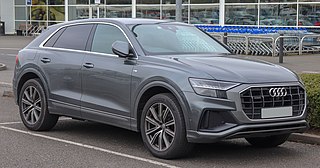
The Audi Q8 is a mid-size luxury crossover SUV coupé made by Audi that was launched in 2018. It is the flagship of the Audi SUV line, and is being produced at the Volkswagen Bratislava Plant.

The BMW i4 is a battery electric compact executive car produced by BMW since 2021. It adopts a five-door liftback body style and is marketed as a four-door coupé. The initial concept version, named BMW i Vision Dynamics, debuted at the 2017 Frankfurt Motor Show. It is the fifth BMW i sub-brand model, and is sold in several variants at different performance levels, including the first battery-electric variant by BMW's motorsport division. The production version was revealed in March 2021 and went on sale in November of the same year as a 2022 model.
Unu is a German manufacturer of electric scooters based in Berlin. In 2014, the company began offering three engine sizes. The vehicles are assembled in China and distributed in Germany, Austria, Switzerland, France and Netherlands.

The Volkswagen ID.4 and Volkswagen ID.5 are battery electric compact crossover SUVs produced by Volkswagen. Based on the MEB platform, the ID.4 is the second model of the Volkswagen ID. series. The production version of the ID.4 debuted in September 2020 as the first fully-electric crossover SUV under the Volkswagen brand, while the coupe-shaped variant of the ID.4 is marketed as the Volkswagen ID.5 and was revealed in November 2021.
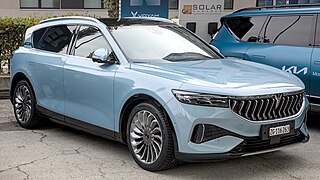
The Voyah Free is a mid-size luxury crossover SUV manufactured by Dongfeng Motor Corporation and marketed by Voyah.
